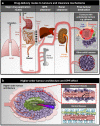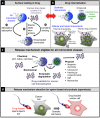Engineering microrobots for targeted cancer therapies from a medical perspective
- PMID: 33154372
- PMCID: PMC7645678
- DOI: 10.1038/s41467-020-19322-7
Engineering microrobots for targeted cancer therapies from a medical perspective
Abstract
Systemic chemotherapy remains the backbone of many cancer treatments. Due to its untargeted nature and the severe side effects it can cause, numerous nanomedicine approaches have been developed to overcome these issues. However, targeted delivery of therapeutics remains challenging. Engineering microrobots is increasingly receiving attention in this regard. Their functionalities, particularly their motility, allow microrobots to penetrate tissues and reach cancers more efficiently. Here, we highlight how different microrobots, ranging from tailor-made motile bacteria and tiny bubble-propelled microengines to hybrid spermbots, can be engineered to integrate sophisticated features optimised for precision-targeting of a wide range of cancers. Towards this, we highlight the importance of integrating clinicians, the public and cancer patients early on in the development of these novel technologies.
Conflict of interest statement
The authors declare no competing interests.
Figures








References
-
- Luo M, Feng Y, Wang T, Guan J. Micro-/nanorobots at work in active drug delivery. Adv. Funct. Mater. 2018;28:1706100. doi: 10.1002/adfm.201706100. - DOI
Publication types
MeSH terms
Substances
Grants and funding
LinkOut - more resources
Full Text Sources
Other Literature Sources
Medical

